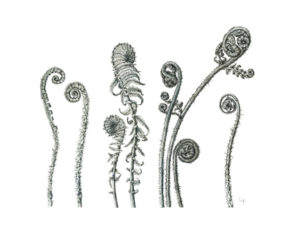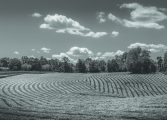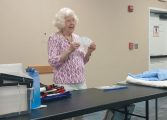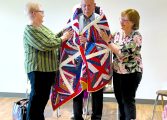By Page H. Gifford, Correspondent
Tiny little tangled roots, fall leaves dried and curled with bits of faded color, peeling bark, are just a few a few things artist and illustrator Lara Call Gastinger finds in the natural world to draw. Her work is painstakingly meticulous and all done in pen and watercolor. She demonstrated her illustrative technique for members of the Fluvanna Art Association May 18.
Gastinger, who lives in Charlottesvi lle, is the chief illustrator for the Flora of Virginia Project, which used to have all the current science information and updates on Virginia flora. Gastinger drew 1,300 illustrations for the project over 10 years.
lle, is the chief illustrator for the Flora of Virginia Project, which used to have all the current science information and updates on Virginia flora. Gastinger drew 1,300 illustrations for the project over 10 years.
“I would collect the specimens, learned about their texture, identify it, sketch it in pencil, send it in for final approval and then draw it in ink,” she said.
She received her undergraduate degree in biology from the University of Virginia and a master’s in plant ecology from Virginia Tech. She shifted her attention to landscape architecture, thinking she would use her creative abilities in that capacity, but then studied art and became an illustrator, encompassing the best of both worlds.
She was awarded a gold medal at the Royal Horticultural Society garden show in London, which she said was not easy since the British are literal when it comes to the natural color of things. Gastinger chose a native Virginia plant, thinking they would not be so familiar with the color, and it worked.
Her illustrations have also been in several American Society of Botanical Artists traveling exhibits and catalogs. Her paintings were accepted into the Hunt Institute for Botanical Documentation and she is represented by Susan Frei Nathan’s Fine Works on Paper. She teaches classes and workshops in Charlottesville at the McGuffey Art Center.
She told the group that her interest in drawing and the natural environment began at an early age.
“You don’t have to go far; you can make your own discoveries in your back yard,” she said. “There is a great benefit to seeing them in the field (their environment) and how they grow and mature.” Some might question why it would be necessary for her as an artist to have the knowledge of a biologist. No matter what is painted or drawn, understanding of structure, anatomy, and texture are required in order to create realism. Even the colors must be accurate.
One of the items that art ists keep with them when in the field or traveling is a journal. Much like writers, who jot down impressions in the moment, artists will capture a scene with a quick sketch. Gastinger showed the group the few items she takes along on her sojourns through nature. She has her small box of watercolors with pigments less than the size of an M&M and a water brush, which is filled with water and has a brush on the end. It is a wonderful traveling option for artists. Gastinger got more creative by using an old Altoids tin box and a plastic gum blister pack and created her own travel watercolor box. Art supplies are so expensive that professional artists find ways to cleverly cut corners.
ists keep with them when in the field or traveling is a journal. Much like writers, who jot down impressions in the moment, artists will capture a scene with a quick sketch. Gastinger showed the group the few items she takes along on her sojourns through nature. She has her small box of watercolors with pigments less than the size of an M&M and a water brush, which is filled with water and has a brush on the end. It is a wonderful traveling option for artists. Gastinger got more creative by using an old Altoids tin box and a plastic gum blister pack and created her own travel watercolor box. Art supplies are so expensive that professional artists find ways to cleverly cut corners.
For paper she likes the 140 lb. Fabriano or Strathmore watercolor paper and uses Micron pens as small as 01 and 005. She also doesn’t mind her pens drying out a little and prefers the scratchier effect in her drawings rather than using a vast amount of ink.
Her journal is a sketchbook, featuring her “observations in the field,” with illustrations and notes beside them. Her drawings in these journals are as beautiful as her finished products. She added that Newcomb’s Wildflower Guide is helpful with identification. She makes her plant observations regarding petals, colors, and other pertinent information.
“Writing things like, ‘It reminds me of,’ or, ‘I wonder,’ helps the creative process,” Gastinger said. She categorizes her journal by season and divides it into pods, twigs, bark, leaves, mushrooms, bean sprouts, seeds, berries and flowers. She added she never uses pencil, just pen. She calls this her “perpetual journal” and uses a separate journal for travel.
For painting she uses 300 lb. hot pressed watercolor paper and size 2-4 watercolor brushes. Like many watercolor artists, she begins with a sweeping wash then adds the very controlled, delicate details.
“I do not do many flowers and I like the evidence of change, decay, and processes that occur in nature,” she said. She gathers her inspiration from things like colorless nuts, a broken seed pod, or insect damage to a leaf. Her goal is to reveal the characteristics of the plant and its uniqueness through her illustrations, and she does this exceptionally well, down to each vein in a leaf.
Not many of the members had ever experienced botanical illustration. They were speechless, watching this quiet meditative artist work in her journal, using a leaf as her subject. Gastinger summed it up best when she stated, “We are on this planet to be in awe of things.”




